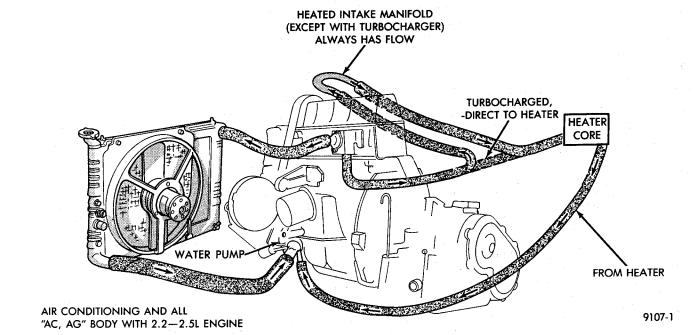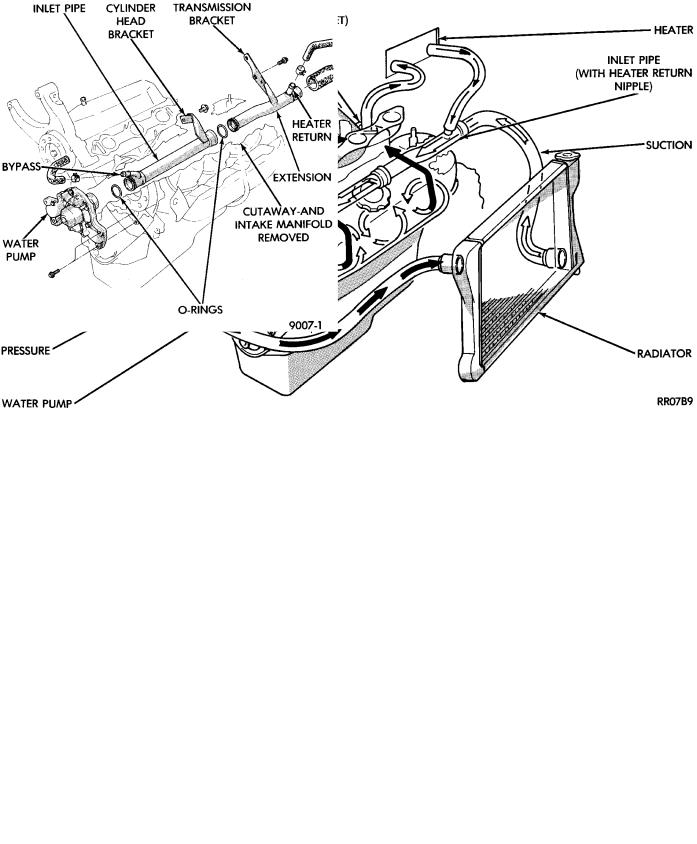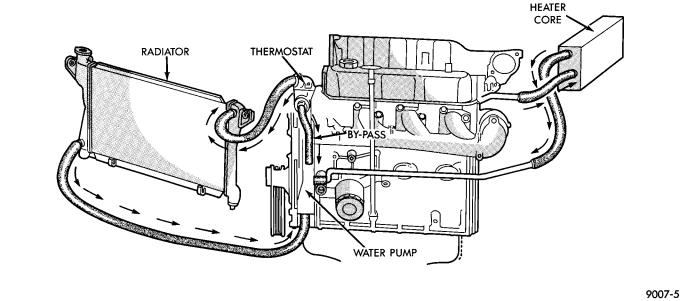
- •GENERAL INFORMATION
- •COOLING SYSTEM
- •TURBOCHARGER COOLANT ROUTING
- •COOLING SYSTEM DIAGNOSIS
- •COOLING SYSTEM DIAGNOSIS
- •COOLING SYSTEM DIAGNOSIS
- •COOLING SYSTEM DIAGNOSIS
- •COOLING SYSTEM DIAGNOSIS
- •COOLING SYSTEM DIAGNOSIS
- •SERVICE PROCEDURES
- •WATER PUMPS
- •ENGINE THERMOSTATS
- •DESCRIPTION AND OPERATION
- •OPERATION AND TESTING
- •REMOVAL
- •COOLANT
- •PERFORMANCE
- •SELECTION AND ADDITIVES
- •SERVICE
- •ROUTINE LEVEL CHECK
- •ADDING ADDITIONAL COOLANT
- •SERVICE COOLANT LEVEL
- •LOW COOLANT LEVEL AERATION
- •DEAERATION
- •COOLING SYSTEM DRAIN, CLEAN, FLUSH AND REFILL
- •DRAINING
- •CLEANING
- •REVERSE FLUSHING
- •CHEMICAL CLEANING
- •REFILLING
- •TESTING SYSTEM FOR LEAKS
- •COOLANT RECOVERY SYSTEM (CRS)
- •RADIATOR PRESSURE CAP
- •PRESSURE TESTING RADIATOR CAPS
- •INSPECTION
- •RADIATORS
- •RADIATOR DRAINCOCK SERVICE
- •RADIATOR COOLANT FLOW CHECK
- •RADIATOR
- •RADIATOR HOSES
- •FANS
- •SINGLE FAN
- •REMOVAL
- •INSTALLATION
- •TEMPERATURE GAUGE INDICATION
- •ELECTRIC FAN MOTOR
- •ELECTRIC FAN MOTOR TEST
- •FAN SHROUD
- •AUTOMATIC TRANSMISSION OIL COOLERS
- •ACCESSORY DRIVE BELTS
- •GENERAL INFORMATION
- •PROPER BELT TENSION
- •ACCESSORY DRIVE BELTS DIAGNOSIS
- •AIR CONDITIONING COMPRESSOR
- •ALTERNATOR BELT
- •AIR CONDITIONING BELT
- •ALTERNATOR, POWER STEERING PUMP, AIR CONDITIONING COMPRESSOR AND WATER PUMP DRIVE BELT
- •ENGINE BLOCK HEATER
- •DESCRIPTION AND OPERATION
- •REMOVAL
- •INSTALLATION
- •SPECIFICATIONS

Ä |
|
COOLING SYSTEM 7 - 1 |
|
COOLING SYSTEM
CONTENTS
|
page |
ACCESSORY DRIVE BELTS . . . . . . . . . . . . . . . |
. 25 |
ENGINE BLOCK HEATER . . . . . . . . . . . . . . . . . |
. 29 |
GENERAL INFORMATION . . . . . . . . . . . . . . . . |
. . 1 |
|
page |
SERVICE PROCEDURES . . . . . . . . . . . . . . . . . |
. 11 |
SPECIFICATIONS . . . . . . . . . . . . . . . . . . . . . . |
. 30 |
GENERAL INFORMATION
Throughout this group, references may be made to a particular vehicle by letter or number designation. A chart showing the breakdown of these designations is included in the Introduction Section at the front of this service manual.
COOLING SYSTEM
The cooling system consists of an engine cooling module, thermostat, coolant, a water pump to circulate the coolant. The engine cooling module may consist of a radiator, electric fan motor, shroud, radiator pressure cap, coolant reserve system, transmission oil cooler, hoses, clamps, air condition condenser, transmission oil lines and charge air cooler.
² When Engine is cold: Thermostat is closed, cooling system has no flow through the radiator. The coolant bypass flows through the engine only.
² When Engine is warm: Thermostat is open, cooling system has bypass flow and coolant flow through radiator.
Its primary purpose is to maintain engine temperature in a range that will provide satisfactory engine performance and emission levels under all expected driving conditions. It also provides hot water (coolant) for heater performance and cooling for automatic transmission oil. It does this by transferring heat from engine metal to coolant, moving this heated coolant to the radiator, and then transferring this heat to the ambient air.
Coolant flow circuits for 2.2L and 2.5L engine equipped vehicles are shown in (Fig 1). Turbocharged equipped engines coolant routing and plumbing are shown in (Fig 2). The 3.0L engine coolant routing is shown in (Fig 3). The 3.3L and 3.8L engine coolant routing is shown in (Fig 5).
Fig. 1 Cooling System OperationÐ2.2/2.5L Engines

7 - 2 COOLING SYSTEM |
|
Ä |
|
Fig. 2 Turbocharger-Tube Hose Assemblies and Coolant Routing

Ä |
|
COOLING SYSTEM 7 - 3 |
|
Fig. 3 Cooling System OperationÐ3.0L Engine
TURBOCHARGER COOLANT ROUTING
Engines equipped with a Turbocharger maintain a continuous engine coolant flow through the Turbocharger bearing housing water jacket. Hose and tube assemblies provide a closed loop coolant flow from the cylinder block water jacket to the turbocharger housing and back to the cylinder head waterbox (Fig. 2).
Excluding heated intake manifold hose routing (hose is routed from waterbox directly to heater), all other system functions are essentially the same as shown for standard engines.
During any reassembly procedures all pipe fittings in water jacket, bearing housing and waterbox require cleaning and application of thread sealant for entire length of threads. Tighten all fittings to torque specified in (Fig 2).
WATER PIPESÐ3.0L
The 3.0L engines use metal piping beyond the lower radiator hose to route coolant to the suction side of water pump, located in the V of the cylinder banks.
These pipes are also provided with inlet nipples for thermostat bypass and heater return coolant hos-
es,and brackets for rigid engine attachment. The pipes employ O-rings for sealing at their interconnection and to the water pump (Fig. 4).
Fig. 4 Engine Inlet Coolant Pipes

7 - 4 COOLING SYSTEM |
|
Ä |
|
Fig. 5 Cooling System OperationÐ3.3/3.8L Engines
